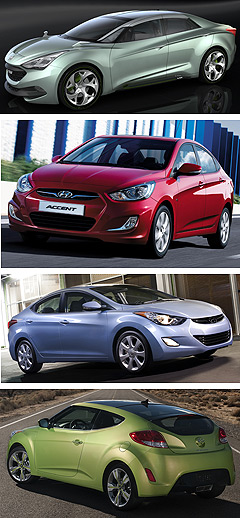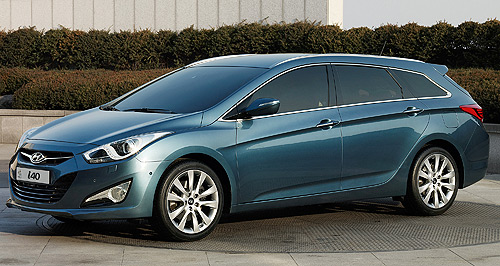Make / Model Search
Future models - Hyundai - i40Hyundai Veloster caps 2011 model rollouti40: Hyundai's mid-sized wagon is among an influx of product set for local launch by the Korean giant. Four new Hyundai models by year’s end but still room for i40 sedan21 Mar 2011 HYUNDAI’S new Veloster coupe will cap four new models joining the Korean company’s Australian line-up this year, with the European-developed i40 mid-sized wagon and the new-generation Accent and Elantra sedans all confirmed for local launch. The groundbreaking Veloster, which received its first public airing outside of a motor show in Sydney at the weekend, will arrive at the end of the year, just after the new i40 wagon. The Accent and Elantra – sedan counterparts for the light-sized i20 and successful i30 small hatch – will arrive in quick succession in the third quarter. However, these new sedans will retain the global Accent and Elantra names, eschewing the ‘i’ moniker system attached to other Hyundais launched locally in recent years, as will the Veloster. All models feature the ‘fluidic sculpture’ design language that debuted last year with the ix35 SUV and i45 mid-size sedan. The i40 wagon – which emerged in production form at Geneva earlier this month – will complement the related i45 sedan and compete head-on with wagon versions of the Ford Mondeo, Mazda6 and upcoming new Volkswagen Passat. Benchmarked against the Volkswagen Passat and European Toyota Avensis, the i40 will have a more premium fit, finish and feel than the i45. Hyundai Motor Company Australia (HMCA) senior manager for product planning Roland Rivero told GoAuto that the as-yet-unrevealed i40 sedan variant, which is expected to take styling cues from the 2010 i-flow Geneva concept, could later join the wagon and be sold alongside the i45 similar to Honda’s Accord/Accord Euro line-up.  From top: Hyundai i-flow concept, Hyundai Accent, Hyundai Elantra, Hyundai Veloster. From top: Hyundai i-flow concept, Hyundai Accent, Hyundai Elantra, Hyundai Veloster.“There is an i40 sedan for the European market, but we’ve got to study it from our end as I’m mindful of where i45 is,” said Mr Rivero. “The i45’s been pretty successful for us, so we’ve got to be careful of incremental volume versus cannibalisation. “If we do bring in the i40 sedan I’ll aim to make sure it is a rationalised situation in which I can get incremental models and perhaps that could work in an environment whereby the sedan acts like the Accord Euro to the Accord.” While no line-up, specification or engine details will be revealed until closer to the time of launch, GoAuto has previously reported that the European i40 wagon’s engine line-up will include a new 1.7-litre diesel engine reportedly offered in two states of tune and emitting a low 113 grams per kilometre of CO2. The option of a diesel powerplant no doubt will add to the appeal of Hyundai’s mid-size offering in Australia as the local market becomes increasingly fond of the fuel. Mr Rivero said the i40 would “feature all-new technologies never seen before on a Hyundai product or for that matter, on our competitors in the medium segment,” but would not be drawn on what these might be. The active demist system that automatically detects and clears mist from the windscreen as featured on the i40 Geneva show car is one likely candidate for class-first technology. Mr Rivero simply offered that Hyundai was aiming to have at least one segment-first feature on each model it launched. Hyundai provided no indicative pricing for the i40 wagon, but Mr Rivero said Hyundai anticipated it will be marginally higher than the i45 price, “taking into account of course that there is a wagon premium as well”. “It will carry even more premium features than the i45 on top of the attention to detail and quality of the product, the fit and finishes.” Mindful of the fact that its second-biggest seller – the Getz light car – is out of production and stocks will dry up mid-year, Hyundai will attempt to drive light volume with the Accent sedan and possibly a diesel-engined i20, for which the company has received Australian Design Rule certification. Replacing its slow-selling namesake, the new Elantra will not be named i35 as expected, due to a new global naming strategy. Models designed primarily for Europe receive the i-prefixed model designations while vehicles for the general and North American markets will continue with names. The strategy leaves Australia in an odd position when it comes to naming, as Hyundai’s local outpost cherry-picks available right-hand drive models from all markets to suit Australia’s unique automotive landscape. As a result, Australian-delivered Hyundais will be badged with a confusing mix of ‘i-series’ and noun-based nomenclature. The new Elantra could provide Hyundai with the extra volume it needs to become small car king when it arrives in Q3, triumphing over the likes of Toyota’s Corolla, and the Mazda3, both of which offer a sedan variant. Described by Hyundai as “sporty and aerodynamic”, with a “powerful and assertive stance” the Elantra’s sleek profile is achieved by a low the roof line and short front and rear overhangs. The Elantra’s interior, revealed last July as the first example of the Korean brand’s new ‘Wind Craft’ interior design language, complements the stylish bodywork and promises to offer plenty of showroom appeal. Again, no local specifications are yet confirmed, but as GoAuto has reported, expect the Elantra to be powered by a 1.6-litre direct-injection petrol four that delivers 103kW and 167Nm of torque, linked to a six-speed automatic transmission. Hyundai will be hoping its two-pronged i30/new Elantra attack on the small car segment will reclaim ground lost to Holden’s Cruze, which so far this year is outselling the i30 and current Elantra by more than 200 units. When it goes on sale soon after the Elantra, what Hyundai calls its “premium light” sedan will be sold as the Accent rather than the expected i25. The Accent’s interior looks more upmarket and modern than that of its i20 sibling and Mr Rivero said that the Accent is designed to be a practical, premium light car that will appeal to both rational and emotional buyers. “The styling is rather funky and modern, embracing the ‘fluidic sculpture’ design language,” he said. “The six-sided shape of the hexagonal grille exudes an image of authority and distinction while the headlights, which curve and wrap around to the sides of the bodywork are designed with a very high-tech image.” Unlike the Indian-built i20, the Accent will be sourced from South Korea, where as GoAuto has reported, it is offered with both 1.4-litre Gamma MPI and 1.6-litre Gamma GDI direct-injection petrol engines, as well as twin front and side curtain airbags, electronic stability control and ABS brakes. As with the i20, a diesel version of the Accent will also be available to HMCA should it choose to introduce an oil-burning light car. After a 26.6 per cent leap in sales last year to 80,038, HMCA is experiencing a slow start to 2011 with overall sales year to date of 13,017 – a three per cent drop. With 3623 sales, the Getz tops the light car sales charts by a comfortable margin while the i30 occupies fourth place in the small segment with 4329 sales.
 Read more21st of March 2011  Hyundai’s radical Veloster coupe hitsSydney hosts Hyundai’s first public showing of Veloster outside a motor show18th of February 2011  Geneva show: Hyundai reveals i40 wagon in full fleshHyundai takes the wraps off sleek new i40 mid-size wagon ahead of Geneva world debut8th of February 2011  Hyundai to debut i40 wagon at GenevaHyundai teases with i40 interior shot ahead of its world debut at Geneva24th of December 2010  First look: Hyundai’s new Accent hits ChinaNew-generation Hyundai Accent hatch to join sedan, but not in Australia21st of December 2010  First look: Hyundai uncovers new i40 wagonAll-new i40 emerges as Hyundai Australia considers a wagon sibling for i45 sedan4th of November 2010  Accent to fill Getz shoes for HyundaiHyundai to fill Getz void with redesigned Accent sedan within 12 months11th of October 2010  More new Hyundais on the wayReplacements for Hyundai’s Getz, Accent, Elantra and Tiburon on the cards soon21st of July 2010  First look inside: Hyundai unveils latest classy cabinHyundai unveils the stunning new interior of its next-generation small sedanAll future models Alfa Romeo Alfa Romeo Abarth Abarth Audi Audi Aston Martin Aston Martin BMW BMW Bentley Bentley Chrysler Chrysler Chevrolet Chevrolet Dodge Dodge Citroen Citroen Ferrari Ferrari DS DS Ford Ford Fiat Fiat FPV FPV Foton Foton Haval Haval Great Wall Great Wall Honda Honda Holden Holden Hyundai Hyundai HSV HSV Isuzu Isuzu Infiniti Infiniti Jeep Jeep Jaguar Jaguar Lamborghini Lamborghini Kia Kia Lexus Lexus Land Rover Land Rover Mazda Mazda Maserati Maserati Mercedes-Benz Mercedes-Benz McLaren McLaren Mini Mini Nissan Nissan Mitsubishi Mitsubishi Peugeot Peugeot Opel Opel Proton Proton Porsche Porsche Renault Renault Ram Ram Saab Saab Rolls-Royce Rolls-Royce Smart Smart Skoda Skoda Subaru Subaru SsangYong SsangYong Tesla Tesla Suzuki Suzuki Toyota Toyota Volvo Volvoi40 pricing
Motor industry news |
Click to shareHyundai modelsResearch Hyundai All future models Alfa Romeo Alfa Romeo Abarth Abarth Audi Audi Aston Martin Aston Martin BMW BMW Bentley Bentley Chrysler Chrysler Chevrolet Chevrolet Dodge Dodge Citroen Citroen Ferrari Ferrari DS DS Ford Ford Fiat Fiat FPV FPV Foton Foton Haval Haval Great Wall Great Wall Honda Honda Holden Holden Hyundai Hyundai HSV HSV Isuzu Isuzu Infiniti Infiniti Jeep Jeep Jaguar Jaguar Lamborghini Lamborghini Kia Kia Lexus Lexus Land Rover Land Rover Mazda Mazda Maserati Maserati Mercedes-Benz Mercedes-Benz McLaren McLaren Mini Mini Nissan Nissan Mitsubishi Mitsubishi Peugeot Peugeot Opel Opel Proton Proton Porsche Porsche Renault Renault Ram Ram Saab Saab Rolls-Royce Rolls-Royce Smart Smart Skoda Skoda Subaru Subaru SsangYong SsangYong Tesla Tesla Suzuki Suzuki Toyota Toyota Volvo Volvoi40 pricing
Motor industry news |
||||||||||












Facebook Twitter Instagram